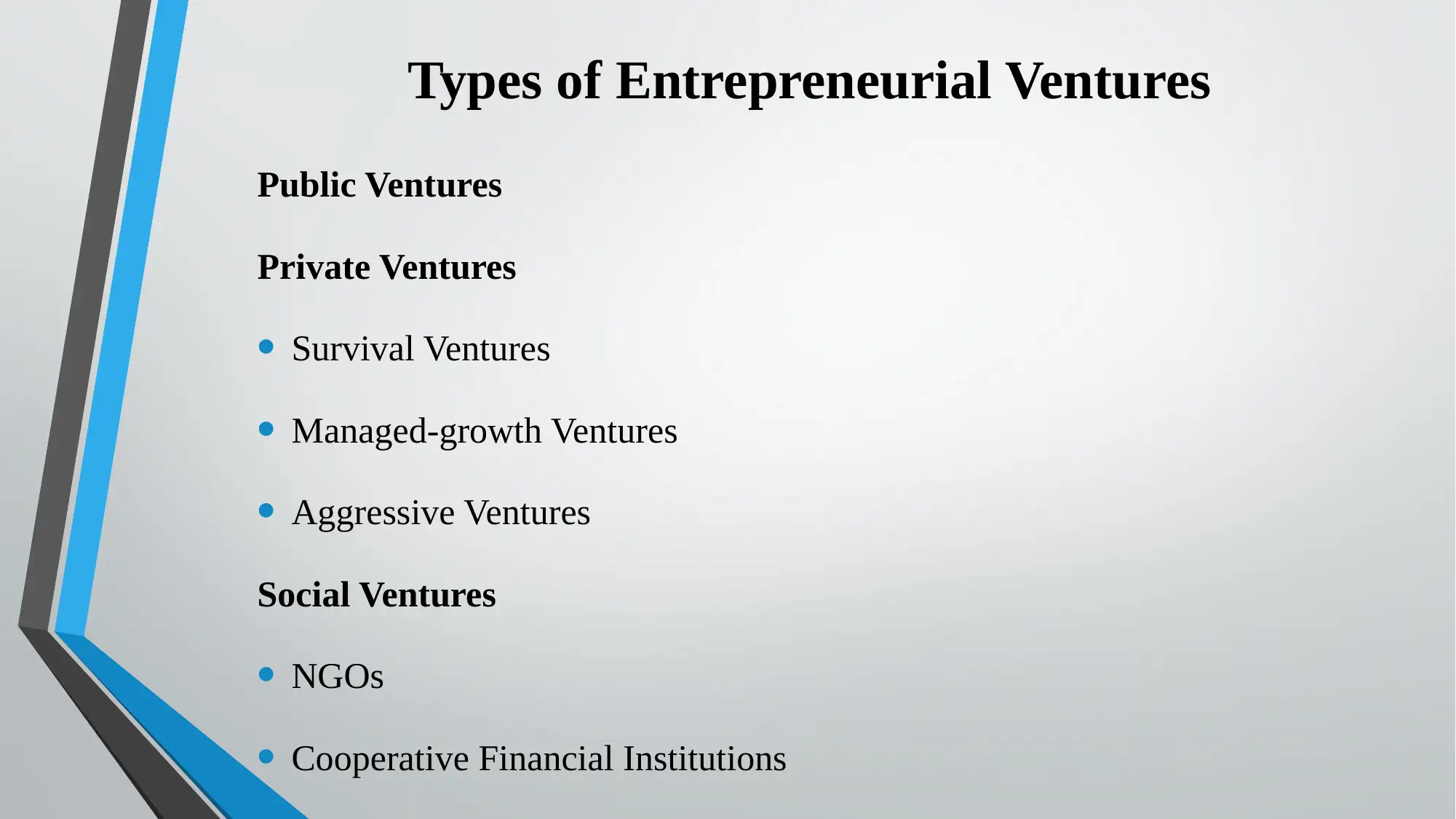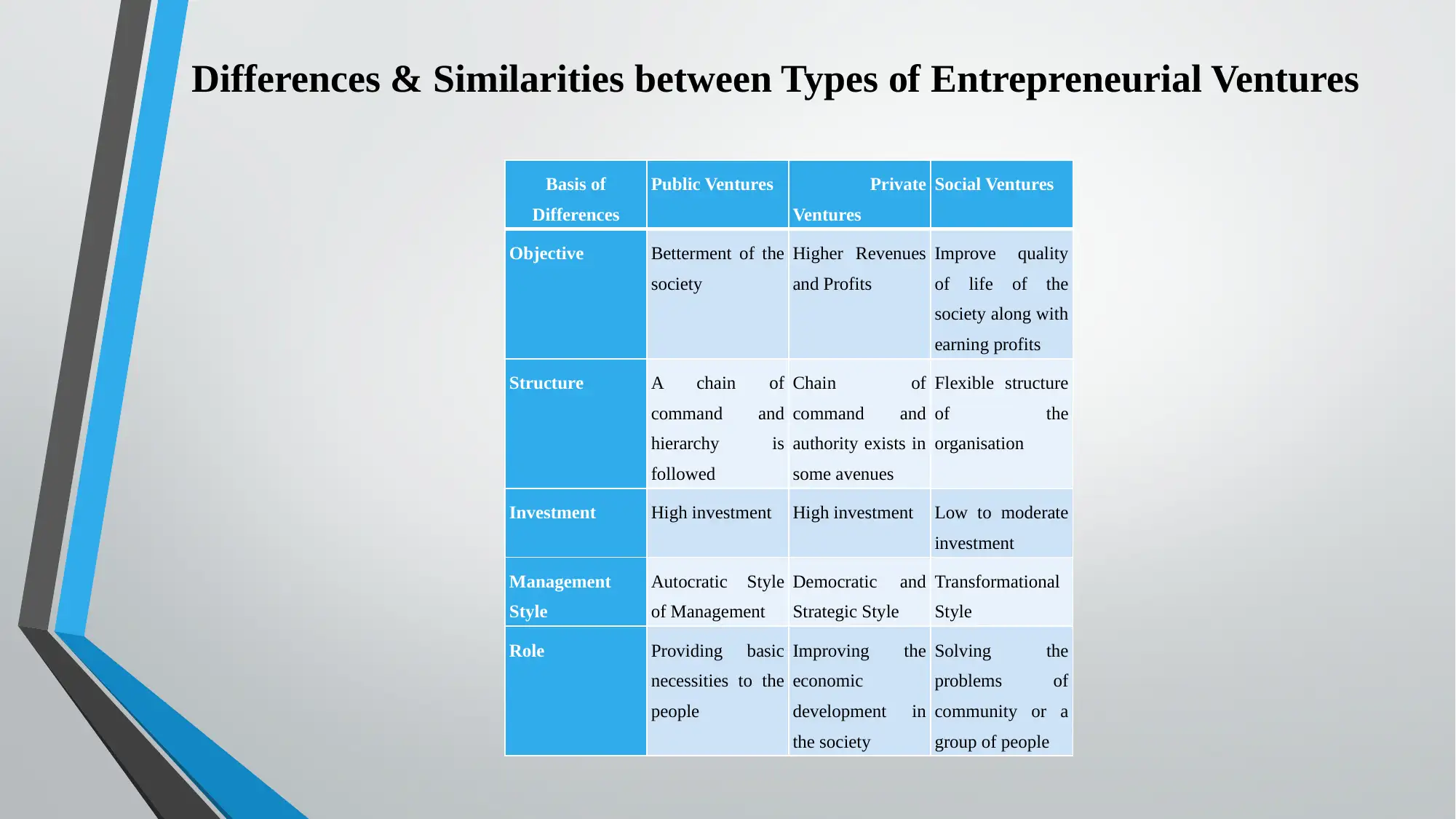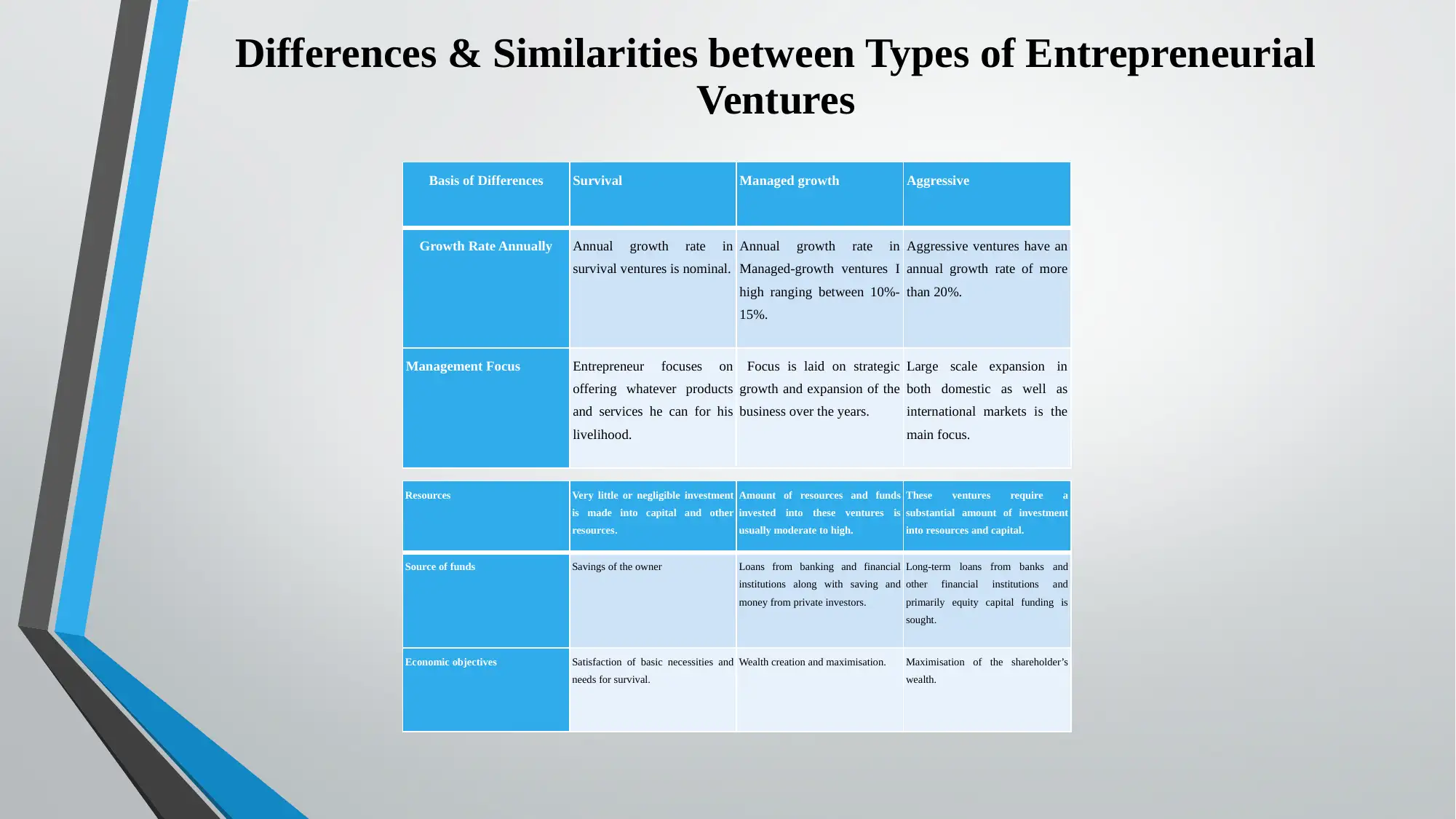Entrepreneurial Ventures: Typology Analysis for UK College Students
VerifiedAdded on 2023/01/11
|10
|725
|42
Report
AI Summary
This report defines entrepreneurship and explores various types of entrepreneurial ventures, including public, private (survival, managed-growth, aggressive), and social ventures (NGOs, cooperative financial institutions). It analyzes the similarities and differences between these ventures based on objectives, structure, investment, management style, and growth rate. The report concludes that understanding the nuances of each venture type is crucial for investors and entrepreneurs, highlighting the importance of context and strategic focus. Access more solved assignments and study resources on Desklib.

Entrepreneurship and Small
Business Management
(TASK 1)
Business Management
(TASK 1)
Paraphrase This Document
Need a fresh take? Get an instant paraphrase of this document with our AI Paraphraser

TABLE OF CONTENT
• Introduction
• Entrepreneurship
• Types of Entrepreneurial Ventures
• Differences & Similarities between Types of Entrepreneurial
Ventures
• Conclusion
• References
• Introduction
• Entrepreneurship
• Types of Entrepreneurial Ventures
• Differences & Similarities between Types of Entrepreneurial
Ventures
• Conclusion
• References

Introduction
In this presentation, an attempt has been made to determine the concept of
entrepreneurship and evaluate the different types of entrepreneurial ventures
with reference to the typology. An attempt has also been made to identify the
similarities and differences between various kinds of entrepreneurial ventures.
The presentation is prepared for the team of investors from London Chamber of
Commerce.
In this presentation, an attempt has been made to determine the concept of
entrepreneurship and evaluate the different types of entrepreneurial ventures
with reference to the typology. An attempt has also been made to identify the
similarities and differences between various kinds of entrepreneurial ventures.
The presentation is prepared for the team of investors from London Chamber of
Commerce.
⊘ This is a preview!⊘
Do you want full access?
Subscribe today to unlock all pages.

Trusted by 1+ million students worldwide

Entrepreneurship
Entrepreneurship can be defined as the process which involves planning,
designing, coordinating and controlling the various activities and tasks related
with offering a product or service to the consumers with an objective of earning
higher revenues and profits in the future.
Entrepreneurship can be defined as the process which involves planning,
designing, coordinating and controlling the various activities and tasks related
with offering a product or service to the consumers with an objective of earning
higher revenues and profits in the future.
Paraphrase This Document
Need a fresh take? Get an instant paraphrase of this document with our AI Paraphraser

Types of Entrepreneurial Ventures
Public Ventures
Private Ventures
• Survival Ventures
• Managed-growth Ventures
• Aggressive Ventures
Social Ventures
• NGOs
• Cooperative Financial Institutions
Public Ventures
Private Ventures
• Survival Ventures
• Managed-growth Ventures
• Aggressive Ventures
Social Ventures
• NGOs
• Cooperative Financial Institutions

Differences & Similarities between Types of Entrepreneurial Ventures
Basis of
Differences
Public Ventures Private
Ventures
Social Ventures
Objective Betterment of the
society
Higher Revenues
and Profits
Improve quality
of life of the
society along with
earning profits
Structure A chain of
command and
hierarchy is
followed
Chain of
command and
authority exists in
some avenues
Flexible structure
of the
organisation
Investment High investment High investment Low to moderate
investment
Management
Style
Autocratic Style
of Management
Democratic and
Strategic Style
Transformational
Style
Role Providing basic
necessities to the
people
Improving the
economic
development in
the society
Solving the
problems of
community or a
group of people
Basis of
Differences
Public Ventures Private
Ventures
Social Ventures
Objective Betterment of the
society
Higher Revenues
and Profits
Improve quality
of life of the
society along with
earning profits
Structure A chain of
command and
hierarchy is
followed
Chain of
command and
authority exists in
some avenues
Flexible structure
of the
organisation
Investment High investment High investment Low to moderate
investment
Management
Style
Autocratic Style
of Management
Democratic and
Strategic Style
Transformational
Style
Role Providing basic
necessities to the
people
Improving the
economic
development in
the society
Solving the
problems of
community or a
group of people
⊘ This is a preview!⊘
Do you want full access?
Subscribe today to unlock all pages.

Trusted by 1+ million students worldwide

Differences & Similarities between Types of Entrepreneurial
Ventures
Basis of Differences Survival Managed growth Aggressive
Growth Rate Annually Annual growth rate in
survival ventures is nominal.
Annual growth rate in
Managed-growth ventures I
high ranging between 10%-
15%.
Aggressive ventures have an
annual growth rate of more
than 20%.
Management Focus Entrepreneur focuses on
offering whatever products
and services he can for his
livelihood.
Focus is laid on strategic
growth and expansion of the
business over the years.
Large scale expansion in
both domestic as well as
international markets is the
main focus.
Resources Very little or negligible investment
is made into capital and other
resources.
Amount of resources and funds
invested into these ventures is
usually moderate to high.
These ventures require a
substantial amount of investment
into resources and capital.
Source of funds Savings of the owner Loans from banking and financial
institutions along with saving and
money from private investors.
Long-term loans from banks and
other financial institutions and
primarily equity capital funding is
sought.
Economic objectives Satisfaction of basic necessities and
needs for survival.
Wealth creation and maximisation. Maximisation of the shareholder’s
wealth.
Ventures
Basis of Differences Survival Managed growth Aggressive
Growth Rate Annually Annual growth rate in
survival ventures is nominal.
Annual growth rate in
Managed-growth ventures I
high ranging between 10%-
15%.
Aggressive ventures have an
annual growth rate of more
than 20%.
Management Focus Entrepreneur focuses on
offering whatever products
and services he can for his
livelihood.
Focus is laid on strategic
growth and expansion of the
business over the years.
Large scale expansion in
both domestic as well as
international markets is the
main focus.
Resources Very little or negligible investment
is made into capital and other
resources.
Amount of resources and funds
invested into these ventures is
usually moderate to high.
These ventures require a
substantial amount of investment
into resources and capital.
Source of funds Savings of the owner Loans from banking and financial
institutions along with saving and
money from private investors.
Long-term loans from banks and
other financial institutions and
primarily equity capital funding is
sought.
Economic objectives Satisfaction of basic necessities and
needs for survival.
Wealth creation and maximisation. Maximisation of the shareholder’s
wealth.
Paraphrase This Document
Need a fresh take? Get an instant paraphrase of this document with our AI Paraphraser

CONCLUSION
It can be concluded from the presentation that there are various types of
entrepreneurial ventures such as public ventures, private ventures including
managed-growth, survival and aggressive and private ventures including NGOs
and Cooperative Financial Institutions. It can also be concluded that there are
many similarities and dissimilarities between the various types and kinds of
entrepreneurial ventures that may exist in an economy.
It can be concluded from the presentation that there are various types of
entrepreneurial ventures such as public ventures, private ventures including
managed-growth, survival and aggressive and private ventures including NGOs
and Cooperative Financial Institutions. It can also be concluded that there are
many similarities and dissimilarities between the various types and kinds of
entrepreneurial ventures that may exist in an economy.

REFERENCES
Autio, E., Kenney, M., Mustar, P., Siegel, D. and Wright, M., 2014. Entrepreneurial
innovation: The importance of context. Research policy. 43(7). pp.1097-1108.
Drucker, P., 2014. Innovation and entrepreneurship. Routledge.
Katre, A. and Salipante, P., 2012. Start‐up social ventures: Blending fine‐grained
behaviors from two institutions for entrepreneurial success. Entrepreneurship Theory and
Practice. 36(5). pp.967-994.
Kuratko, D.F., 2016. Entrepreneurship: Theory, process, and practice. Cengage Learning.
Neumeyer, X. and Santos, S.C., 2018. Sustainable business models, venture typologies,
and entrepreneurial ecosystems: A social network perspective. Journal of Cleaner
Production. 172. pp.4565-4579.
Verbeke, A., Amin Zargarzadeh, M. and Osiyevskyy, O., 2014. Internalization theory,
entrepreneurship and international new ventures. Multinational Business Review. 22(3).
p.246.
Autio, E., Kenney, M., Mustar, P., Siegel, D. and Wright, M., 2014. Entrepreneurial
innovation: The importance of context. Research policy. 43(7). pp.1097-1108.
Drucker, P., 2014. Innovation and entrepreneurship. Routledge.
Katre, A. and Salipante, P., 2012. Start‐up social ventures: Blending fine‐grained
behaviors from two institutions for entrepreneurial success. Entrepreneurship Theory and
Practice. 36(5). pp.967-994.
Kuratko, D.F., 2016. Entrepreneurship: Theory, process, and practice. Cengage Learning.
Neumeyer, X. and Santos, S.C., 2018. Sustainable business models, venture typologies,
and entrepreneurial ecosystems: A social network perspective. Journal of Cleaner
Production. 172. pp.4565-4579.
Verbeke, A., Amin Zargarzadeh, M. and Osiyevskyy, O., 2014. Internalization theory,
entrepreneurship and international new ventures. Multinational Business Review. 22(3).
p.246.
⊘ This is a preview!⊘
Do you want full access?
Subscribe today to unlock all pages.

Trusted by 1+ million students worldwide

THANK YOU
1 out of 10
Related Documents
Your All-in-One AI-Powered Toolkit for Academic Success.
+13062052269
info@desklib.com
Available 24*7 on WhatsApp / Email
![[object Object]](/_next/static/media/star-bottom.7253800d.svg)
Unlock your academic potential
Copyright © 2020–2025 A2Z Services. All Rights Reserved. Developed and managed by ZUCOL.



